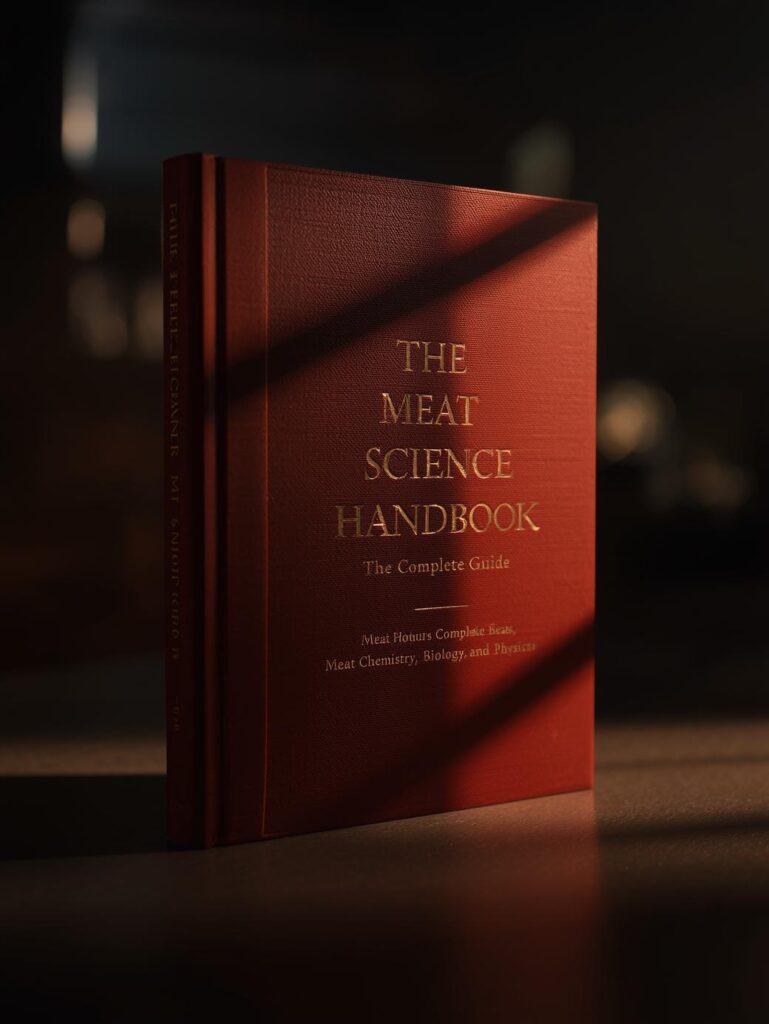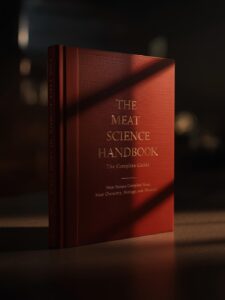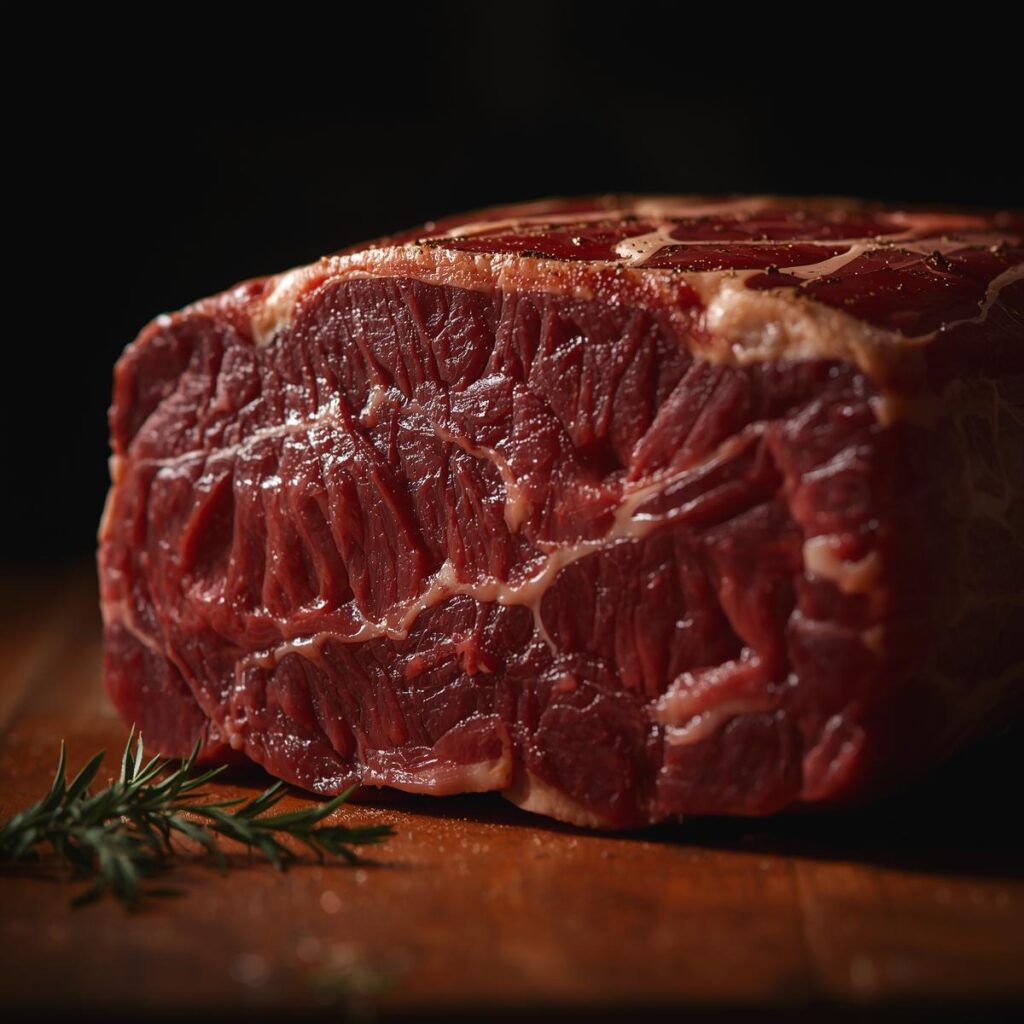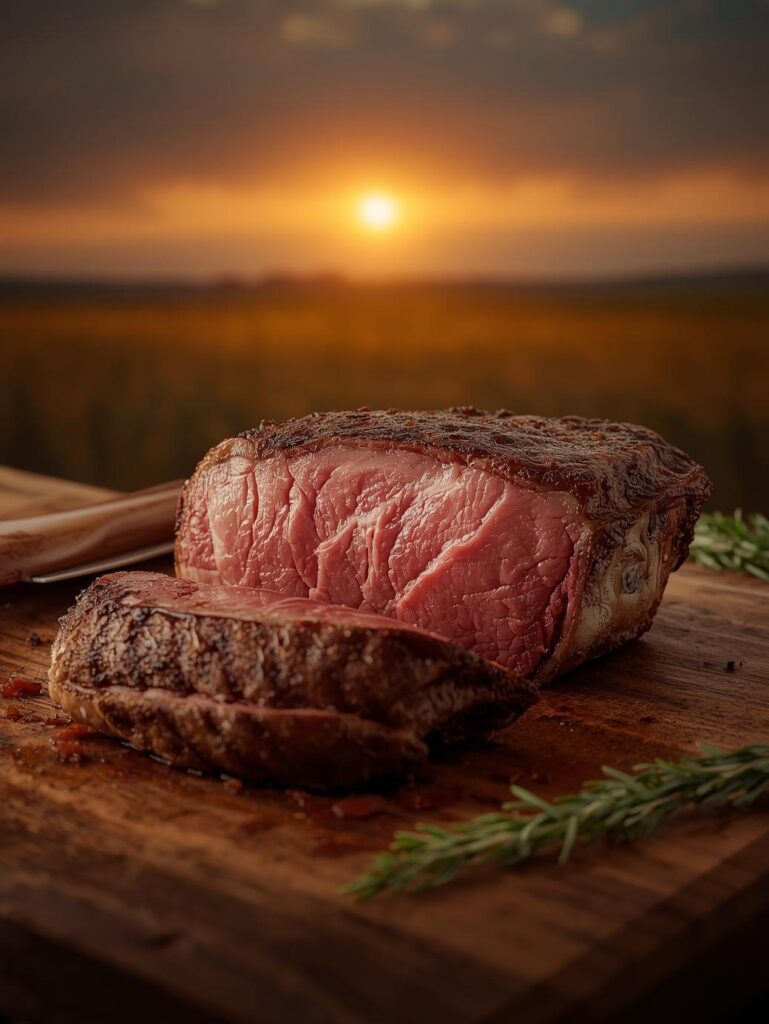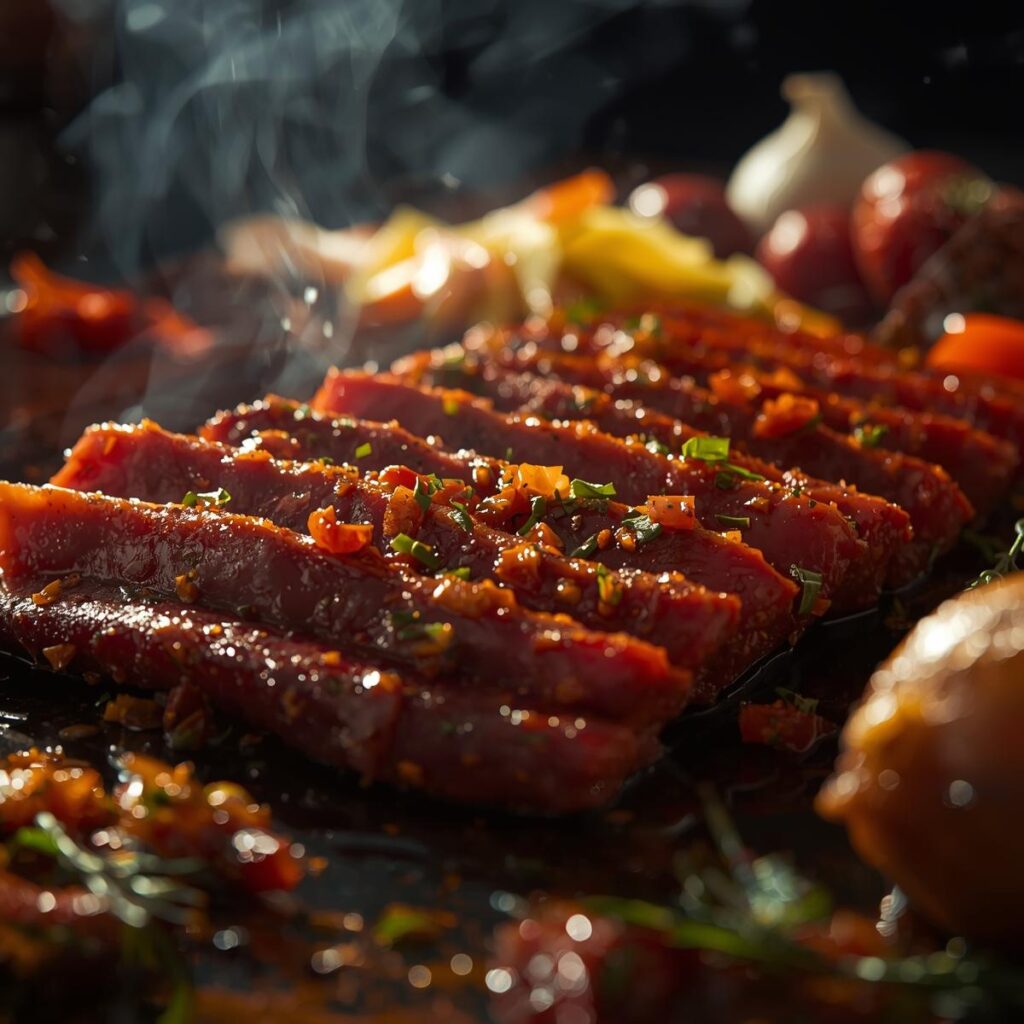Expert’s Note: This handbook synthesizes decades of meat science research with practical cooking applications. It connects the dots between our fundamental meat science guide, advanced aging techniques, and quality assessment methods. Consider this your graduate-level textbook for understanding not just how to cook meat, but why it behaves the way it does at every stage from pasture to plate.
The Meat Science Handbook: The Complete Guide to Meat Chemistry, Biology, and Physics
“Meat science is the bridge between the living animal and the perfect steak. It’s understanding that every cut tells a story of muscle function, every marinade is a chemical reaction, every sear is a thermodynamic event. When you grasp the science, you stop following recipes and start understanding principles. You don’t just cook—you engineer flavor, texture, and experience through applied biochemistry and physics.”
The Meat Science Handbook: The Complete Guide to Meat Chemistry, Biology, and Physics
Download the Meat Science Quick Reference - Chemical Reactions & Temperature Thresholds
Welcome to the most comprehensive meat science resource available outside academic institutions. This handbook transforms you from someone who cooks meat into someone who understands meat at a molecular level. Whether you’re troubleshooting a tough brisket, optimizing a marinade, or simply wondering why meat browns, the answers lie in understanding the fundamental science. This guide makes that science accessible, practical, and immediately applicable to every piece of meat you’ll ever cook.
🎯 THE FOUNDATIONS: MEAT’S MOLECULAR ARCHITECTURE
Understanding what meat is at the cellular level is the first step to mastering it.
⚙️ The Cellular Structure of Meat
From Muscle Fiber to Myofibril
- Muscle Fibers: The basic structural units, long cylindrical cells that contain myofibrils. Their diameter and density determine meat texture. Well-exercised muscles have thicker fibers, resulting in tougher meat.
- Myofibrils: The contractile elements within muscle fibers, composed of actin and myosin filaments. These proteins are responsible for muscle contraction and become the primary source of protein in meat.
- Connective Tissue: The scaffolding that supports muscle fibers. Composed primarily of collagen (which converts to gelatin when heated) and elastin (which remains tough). The amount and distribution determine which cooking method is appropriate.
- Intramuscular Fat (Marbling): Fat deposits within the muscle tissue. Unlike connective tissue, marbling melts during cooking, basting the meat from within and contributing to juiciness and flavor. Learn more in our Marbling Explained Guide.
- Water Content: Muscle is approximately 75% water. How this water is retained or lost during cooking determines juiciness. The water is held within and between muscle fibers by protein structures.
📊 The Meat Composition Matrix
🎯 Chemical Composition of Common Meats (Percentage by Weight)
| Meat Type | Water | Protein | Fat | Minerals/Other | Key Characteristic |
|---|---|---|---|---|---|
| Beef (Choice) | 57% | 17% | 25% | 1% | High myoglobin, robust flavor |
| Pork (Loin) | 68% | 20% | 10% | 2% | Lighter color, sweet flavor |
| Chicken (Breast) | 70% | 23% | 5% | 2% | Very lean, delicate structure |
| Lamb (Leg) | 65% | 20% | 14% | 1% | Distinct fatty acid profile |
| Salmon | 64% | 20% | 15% | 1% | High omega-3 content |
🔥 THE PHYSICS OF HEAT TRANSFER IN MEAT
Understanding how heat moves through meat is the key to perfect cooking.
🎯 The Three Mechanisms of Heat Transfer
How Energy Transforms Meat Structure
- Conduction: Direct transfer of heat through physical contact. This is what happens when meat touches a hot pan or grill grates. The rate depends on the temperature difference and the contact quality. This is why proper searing contact is crucial.
- Convection: Transfer of heat through a fluid medium (air, water, oil). In oven roasting, hot air transfers heat to the meat’s surface. In sous vide, water transfers heat efficiently. Convection cooking is generally more even than conduction alone.
- Radiation: Transfer of heat through electromagnetic waves. Infrared radiation from coals or broiler elements can reach temperatures much higher than air, explaining why radiant heat creates superior crust development.
- Thermal Conductivity: Meat is a poor conductor of heat (about 1/3 that of copper). This is why thick cuts take time to cook through and why a reverse sear works so well—gentle heating avoids a large temperature gradient.
🧪 THE CHEMISTRY OF COOKING: KEY REACTIONS
The most important chemical transformations that occur during cooking.
🥩 Protein Denaturation
The Structural Transformation
- What Happens: Protein molecules unfold and lose their native structure when heated. The coiled proteins straighten and then tangle with adjacent proteins.
- Temperature Range: Begins around 104°F (40°C) and continues through 158°F (70°C)
- Visual Cues: Meat changes from translucent to opaque. Myoglobin denatures, changing color from red to brown.
- Practical Impact: Muscle fibers tighten, squeezing out water. This is why overcooked meat is dry.
- Optimal Control: Gentle heating minimizes excessive squeezing. This is the science behind sous vide precision.
🔥 Maillard Reaction
The Flavor Development
- What Happens: Amino acids (from proteins) react with reducing sugars at high heat, creating hundreds of new flavor compounds.
- Temperature Range: 284-329°F (140-165°C) optimal
- Visual Cues: Brown crust formation. Not to be confused with caramelization (sugars only).
- Practical Impact: Creates the “seared” flavor and appealing brown color. Requires dry surface and high heat.
- Optimal Control: Pat meat dry thoroughly before searing. Use high-heat methods like in our grilling guide.
💧 Collagen Conversion
The Tenderizing Transformation
- What Happens: Tough collagen fibers break down into soft, gelatinous gelatin through hydrolysis.
- Temperature Range: 160-205°F (71-96°C), faster at higher temperatures
- Visual Cues: Meat becomes fork-tender, develops rich mouthfeel
- Practical Impact: Turns tough cuts tender. Requires time and moisture (braising) or very slow roasting.
- Optimal Control: This is the science behind low and slow BBQ and braising.
📈 CRITICAL TEMPERATURE THRESHOLDS IN MEAT COOKING
The Molecular Events at Key Temperatures
104°F / 40°C
Proteins begin to denature. Meat becomes more tender as enzymes activate.
131°F / 55°C
Collagen begins to shrink significantly. Muscle fibers contract.
150°F / 65°C
Collagen to gelatin conversion accelerates. Myoglobin fully denatured.
284°F / 140°C
Maillard reaction begins. Surface browning and flavor development.
For complete temperature guidance, see our Ultimate Meat Temperature Guide
🔬 THE SCIENCE OF AGING: ENZYMATIC TRANSFORMATION
How time and enzymes transform meat at the molecular level.
⏳ Wet Aging vs. Dry Aging Biochemistry
The Enzymatic Processes
- Calpains (Calcium-Activated Proteases): These enzymes break down the proteins that connect muscle fibers, resulting in increased tenderness. They’re most active in the first 21 days of aging and are deactivated around 104°F (40°C).
- Cathepsins (Lysosomal Proteases): Work more slowly than calpains but continue activity for extended periods. They break down various proteins and contribute to flavor development through amino acid release.
- Collagenase: Enzymes that specifically break down collagen. Their activity is limited in post-mortem muscle but contributes to the tenderization of well-aged meat.
- Lipases: Fat-breaking enzymes that become increasingly important in extended dry aging. They liberate free fatty acids that can oxidize and create complex flavor compounds.
- ATP Breakdown: After slaughter, ATP depletes and muscles enter rigor mortis. Aging allows this rigidity to resolve as enzymes break down the protein structures.
🧂 THE SCIENCE OF SEASONING & MARINADES
How salt, acids, and enzymes interact with meat at the molecular level.
🎯 The Mechanisms of Flavor Penetration
How Seasonings Actually Work
- Osmosis and Diffusion: Salt initially draws moisture out of meat through osmosis. This salty brine then diffuses back into the meat, carrying seasoning deep into the tissue. This is the science behind dry brining.
- Protein Modification: Salt dissolves parts of the protein structure, creating spaces that can hold more water. This is why properly salted meat is juicier.
- Acid Denaturation: Marinades with acidic ingredients (vinegar, citrus) partially denature surface proteins, potentially allowing some flavor penetration. However, they can also make the surface mushy if overused.
- Enzymatic Tenderizers: Ingredients like pineapple (bromelain), papaya (papain), and ginger (zingibain) contain proteolytic enzymes that break down proteins. They work quickly but can make meat mushy if over-marinated.
- Emulsion Formation: Oil in marinades doesn’t penetrate meat but carries fat-soluble flavor compounds and helps distribute seasonings evenly over the surface.
🚨 MEAT SCIENCE TROUBLESHOOTING GUIDE
🎯 Scientific Solutions to Common Problems
| Problem | Scientific Cause | Molecular Explanation | Scientific Solution |
|---|---|---|---|
| Tough, Dry Meat | Overcooked proteins | Excessive protein denaturation and aggregation squeezes out water | Cook to lower final temperature; use gentle heating methods; choose appropriate cuts |
| Gray Band | Overcooked outer layer | Myoglobin denaturation occurs before Maillard reaction can form crust | Use reverse sear; ensure dry surface; higher heat for shorter time |
| Meat Sticking | Protein adhesion | Surface proteins form bonds with cooking surface before crust develops | Higher heat; proper preheating; dry surface; adequate fat |
| Mushy Texture | Enzymatic over-tenderizing | Proteolytic enzymes break down protein structure excessively | Shorter marinade times; avoid certain fruits in marinades; monitor timing |
| Lack of Browning | Insufficient Maillard reaction | Surface moisture prevents temperatures needed for amino acid-sugar reactions | Thoroughly dry surface; higher heat; ensure adequate sugar content |
🔍 ADVANCED MEAT SCIENCE CONCEPTS
Cutting-edge understanding for serious meat enthusiasts.
🔬 Emerging Research and Applications
The Future of Meat Understanding
- Myoglobin Chemistry: Understanding how myoglobin’s oxidation states affect color. Bright red (oxymyoglobin) indicates freshness, brown (metmyoglobin) indicates aging, and purple (deoxymyoglobin) is the native state in vacuum packaging.
- Water Holding Capacity: The ability of meat to retain water during cooking. Affected by pH, protein structure, and cooking method. Higher pH meat (dark cutting beef) has greater water holding capacity.
- Sarcomere Length: The length of the contractile units in muscle fibers affects tenderness. Shorter sarcomeres (from stressed animals) result in tougher meat.
- Fatty Acid Composition: Different animals have different fat compositions affecting flavor and melting points. Lamb’s distinctive flavor comes from branched-chain fatty acids.
- Ultra-High Pressure Processing: Commercial technique using extreme pressure to kill pathogens and modify texture without heat, preserving raw characteristics while ensuring safety.
🏁 THE SCIENCE-INFORMED COOK
Armed with this comprehensive understanding of meat science, you are no longer just following recipes—you are understanding principles. You know why meat browns, why it toughens, why it tenderizes, and how to control these processes deliberately.
The true power of meat science lies in its predictive capability. When you understand what’s happening at the molecular level, you can look at a cut of meat and know which techniques will work best. You can troubleshoot problems not by guessing, but by understanding the underlying causes. You can innovate with confidence, knowing the scientific principles that govern your results.
This handbook is not the end of your journey—it’s the beginning. Every piece of meat you cook now becomes a laboratory for applied science. Every meal becomes an opportunity to refine your understanding and hone your technique based on fundamental principles rather than vague instructions.
The science is now yours. The kitchen awaits your experiments.
🔬 CONDUCT YOUR OWN MEAT EXPERIMENTS →
Take your learning to the next level with practical meat science experiments
Deepen Your Meat Science Knowledge: Explore our complete library of science-based guides.

